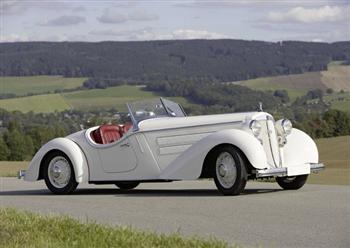|
Home | News | Road Tests | ||||||||||||
Audi at Techno Classica 2009
Audi took an outstanding display of its cars to the world’s largest classic car show, the Techno Classica, which was held in the German city of Essen. To commemorate the centenary of the brand, Audi Tradition had exclusively Audi models on its stand over the week-end. The absolute highlight, reconstruction of which had just been completed, was the 1935 Audi 225 Front Roadster. It was on loan for the occasion from the recently opened special exhibition “Horch – an Audi!” at the museum mobile in Ingolstadt, Germany. The Audi stand was displaying seven cars covering no fewer than nine decades of the company’s history. From the Audi Type C “Alpine Champion” of 1919 to the Audi R10 TDI that won the Le Mans 24-hour race in 2008, each of them, whether production model, racing car or prototype, contributed an exciting story of its own to the Audi centenary celebrations. As before, Audi Tradition was displaying its 1:43 scale “model of the year” on the stand: an Audi Sport quattro S1 Pikes Peak with orange paintwork, of which a limited edition of only 333 has been produced. Visitors to the Essen show saw the following Audi vehicles: the oldest is the Type C “Alpine Champion” with which company founder August Horch won the Austrian Alpine Rally in 1912, 1913 and 1914 – the Audi brand’s first motor sport successes. The Type C was an open tourer with a 35 horsepower engine and a top speed of 80 km/h. Possibly an even greater eye-catcher on the Audi stand was another highlight in the brand’s history: the Audi 225 Front Roadster dating from 1935. Reconstructed on an original chassis frame, this new addition to Audi Tradition’s historic collection is also one of its most spectacular cars. It was first exhibited with a gleaming white paint finish at the 1935 Motor Show in Berlin. Only two prototypes were built; although the car aroused a sensation and was greatly admired, it would have been too expensive for successful series production. Both prototypes have disappeared, and it was therefore decided to build a replica of the Audi 225 Front Roadster by working from photographs. The Audi 72 played an important role in the brand’s history. Introduced on 13th August, 1965 as the Auto Union’s first post-war car with a four-stroke engine, it ushered in a new era for the Ingolstadt-based manufacturer and the abandonment of the two-stroke engine. Between 1965 and 1968 85,000 units of this model, which revived the distinguished Audi name, were sold. A further step back into the premium car class was taken in 1982, when the third-generation (C3) Audi 100 set new standards for aerodynamic efficiency and in many other areas too. The C3 pioneered new design principles and had the outstandingly low drag coefficient of cD = 0.30 – a new world record for a series-production saloon car.
AUDI AG had a high reputation for concept cars to maintain. At the 1991 Motor Show in Frankfurt, the Audi quattro Spyder caused a sensation. It was the most dramatic sports car concept study so far seen from Audi. Powered by a 174 bhp four-stroke engine and with an aluminium body, it could reach a top speed of 250 km/h, but was destined to remain a prototype although Audi dealers received hundreds of purchase options from intending customers. It proved impossible to put the car into production without exceeding the target price of 100,000 Deutschmarks. Audi Tradition illustrated the company’s position in motor sport at the 2009 Techno Classica in an impressive way by displaying the Audi Sport quattro S1 “Pikes Peak” and the Audi R10 TDI. Also nicknamed “The Monster”, the S1 triumphed three times in succession at this hill climb, held on the slopes of a 4,301 metre high mountain in Colorado, USA. Few people will ever forget the way that Walter Röhrl stormed to the top in under eleven minutes, the first driver to achieve this sensational time. This was the last of a series of successes for the Audi Sport quattro S1, since Audi had withdrawn from rallying two years earlier. The Audi R10 TDI is the first sports car to have won the Le Mans 24-hour race with diesel fuel in its tank – and has now pulled off this feat three times in succession. The breathtaking finish in 2008 will not be forgotten: the Audi R10 TDI, which scored its first victory in this event in 2006, fought off the challenge from Peugeot’s car. Motor sport fans will be able to see the 2006 version of the Audi R10 TDI at the Techno Classica in Essen. In 2009, the Audi brand established by August Horch on 16th July, 1909 celebrates its centenary. The four rings of the Audi badge symbolise the brands Audi, DKW, Horch and Wanderer, which were combined to form Auto Union in 1932. Auto Union and NSU, which merged in 1969, both made many significant contributions towards the development of the car. AUDI AG was formed from Audi NSU Auto Union AG in 1985. Together with the two traditional companies Auto Union GmbH and NSU GmbH, Audi Tradition has nurtured the extensive, diverse history of Audi for many years and presented it to the public. The Audi museum mobile at the Audi Forum Ingolstadt is open daily from Monday to Sunday, from 9 a.m. to 6 p.m. The August Horch Museum in Zwickau is open from Tuesday to Sunday from 9.30 a.m. to 5 p.m. | ||||||||||||
More Audi News .....
here
About | Car Clubs | Home | News | Road Ramblings | Road Tests | Subscribe | Top Drive © 2009 All rights reserved. Next Car Pty. Ltd. |




